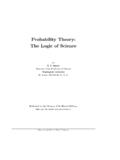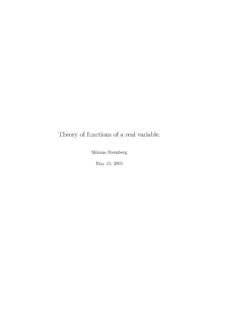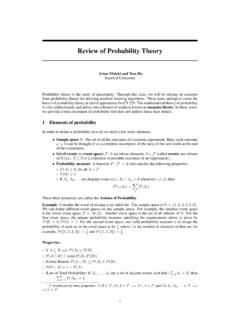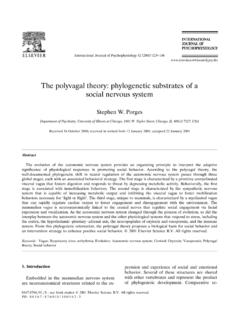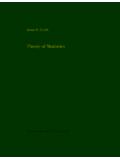Transcription of Probability Theory: The Logic of Science
1 Probability theory : The Logic of Science by E. T. Jaynes Wayman Crow Professor of Physics Washington University St. Louis, MO 63130, U. S. A. Dedicated to the Memory of Sir Harold Jeffreys, who saw the truth and preserved it. Copyright c 1995 by Edwin T. Jaynes. i EDITORS FORWARD. E. T. Jaynes died April 30, 1998. Before his death he asked me to finish and publish his book on Probability theory . I struggled with this for some time, because there is no doubt in my mind that Jaynes wanted this book finished. Unfortunately, most of the later Chapters, Jaynes' intended volume 2 on applications, were either missing or incomplete and some of the early also Chapters had missing pieces. I could have written these latter Chapters and filled the missing pieces, but if I. did so, the work would no longer belong to Jaynes; rather, it would be a Jaynes-Bretthorst hybrid with no way to tell which material came from which author.
2 In the end, I decided that the missing Chapters would have to stay missing the work would remain Jaynes'. There were a number of missing pieces of varying length that Jaynes had marked by inserting the phrase MUCH MORE COMING. I could have left these comments in the text, but they were ugly and they made the book looks very incomplete. Jaynes intended this book to serve as both a reference and a text book. Consequently, there are question boxes scattered throughout most Chapters. In the end, I decided to replace the MUCH MORE COMING comments by introducing an editors question box. If you answer these questions, you will have filled in the missing material. You will be able to identify these questions because I used a shaded box for the editors questions, while Jaynes' question boxes are not shaded. Jaynes' wanted to include a series of computer programs that implemented some of the calcu- lations in this book.
3 I had originally intended to include these programs. But as time went on, it became increasingly obvious that many of the programs were not available and the ones that were, were written in a particularly obscure form of BASIC (it was the programs that were obscure, not the BASIC). Consequently, I removed references to these programs and, where necessary, inserted a few sentences to direct people to the necessary software tools to implement the calculations. Finally, while I am the most obvious person who has worked on getting this book into pub- lication, I am not the only person to do so. Some of Jaynes' closest friends have assisted me in completing this work. These include Tom Grandy, Ray Smith, Tom Loredo, Myron Tribus and John Skilling, and I would like to thank them for their assistance. I would also like to thank Joe Ackerman for allowing me to take the time necessary to get this work published.
4 G. Larry Bretthorst, Editor May 2002. ii Probability theory THE Logic OF Science . VOLUME I PRINCIPLES AND ELEMENTARY APPLICATIONS. Chapter 1 Plausible Reasoning 1. Deductive and Plausible Reasoning 1. Analogies with Physical Theories 3. The Thinking Computer 4. Introducing the Robot 5. Boolean Algebra 6. Adequate Sets of Operations 9. The Basic Desiderata 12. Comments 15. Common Language vs. Formal Logic 16. Nitpicking 18. Chapter 2 The Quantitative Rules 21. The Product Rule 21. The Sum Rule 26. Qualitative Properties 31. Numerical Values 32. Notation and Finite Sets Policy 38. Comments 39. Subjective vs. Objective 39. G odel's Theorem 39. Venn Diagrams 42. The Kolmogorov Axioms 43. Chapter 3 Elementary Sampling theory 45. Sampling Without Replacement 45. Logic Versus Propensity 52. Reasoning from Less Precise Information 56. Expectations 58. Other Forms and Extensions 59.
5 Probability as a Mathematical Tool 60. The Binomial Distribution 61. Sampling With Replacement 63. Digression: A Sermon on Reality vs. Models 64. Correction for Correlations 66. Simplification 71. Comments 72. A Look Ahead 74. Chapter 4 Elementary Hypothesis Testing 77. Prior Probabilities 77. Testing Binary Hypotheses with Binary Data 80. Non-Extensibility Beyond the Binary Case 86. Multiple Hypothesis Testing 88. iii Continuous Probability Distribution functions (pdf's) 95. Testing an Infinite Number of Hypotheses 97. Simple and Compound (or Composite) Hypotheses 102. Comments 103. Etymology 103. What Have We Accomplished? 104. Chapter 5 Queer Uses For Probability theory 107. Extrasensory Perception 107. Mrs. Stewart's Telepathic Powers 107. Digression on the Normal Approximation 109. Back to Mrs. Stewart 109. Converging and Diverging Views 113.
6 Visual Perception Evolution into Bayesianity? 118. The Discovery of Neptune 119. Digression on Alternative Hypotheses 121. Back to Newton 123. Horse racing and Weather Forecasting 124. Discussion 127. Paradoxes of Intuition 128. Bayesian Jurisprudence 128. Comments 130. Chapter 6 Elementary Parameter Estimation 133. Inversion of the Urn Distributions 133. Both N and R Unknown 133. Uniform Prior 135. Predictive Distributions 137. Truncated Uniform Priors 139. A Concave Prior 141. The Binomial Monkey Prior 143. Metamorphosis into Continuous Parameter Estimation 145. Estimation with a Binomial Sampling Distribution 146. Digression on Optional Stopping 148. Compound Estimation Problems 149. A Simple Bayesian Estimate: Quantitative Prior Information 150. From Posterior Distribution Function to Estimate 153. Back to the Problem 156. Effects of Qualitative Prior Information 158.
7 Choice of a Prior 159. On With the Calculation! 160. The Jeffreys Prior 162. The Point of It All 164. Interval Estimation 166. Calculation of Variance 167. Generalization and Asymptotic Forms 168. Rectangular Sampling Distribution 170. Small Samples 172. iv Mathematical Trickery 172. Comments 174. Chapter 7 The Central, Gaussian Or Normal Distribution 177. The Gravitating Phenomenon 177. The Herschel-Maxwell Derivation 178. The Gauss Derivation 180. Historical Importance of Gauss' Result 180. The Landon Derivation 182. Why the Ubiquitous Use of Gaussian Distributions? 185. Why the Ubiquitous Success? 187. What Estimator Should We Use? 188. Error Cancellation 190. The Near-Irrelevance of Sampling Frequency Distributions 192. The Remarkable Efficiency of Information Transfer 193. Other Sampling Distributions 194. Nuisance Parameters as Safety Devices 195.
8 More General Properties 196. Convolution of Gaussians 197. The Central Limit Theorem 197. Accuracy of Computations 200. Galton's Discovery 202. Population Dynamics and Darwinian Evolution 204. Evolution of Humming-Birds and Flowers 206. Application to Economics 207. The Great Inequality of Jupiter and Saturn 208. Resolution of Distributions into Gaussians 209. Hermite Polynomial Solutions 210. Fourier Transform Relations 212. There is Hope After All 213. Comments 214. Chapter 8 Sufficiency, Ancillarity, And All That 217. Sufficiency 217. Fisher Sufficiency 218. Generalized Sufficiency 221. Sufficiency Plus Nuisance Parameters 222. The Likelihood Principle 223. Ancillarity 225. Generalized Ancillary Information 226. Asymptotic Likelihood: Fisher Information 228. Combining Evidence from Different Sources 229. Pooling the Data 231. Sam's Broken Thermometer 233.
9 Comments 235. Chapter 9 Repetitive Experiments Probability And Frequency 241. Physical Experiments 241. v The Poorly Informed Robot 244. Induction 246. Are There General Inductive Rules? 247. Multiplicity Factors 249. Partition Function Algorithms 250. Entropy Algorithms 254. Another Way of Looking at it 257. Entropy Maximization 258. Probability and Frequency 260. Significance Tests 261. Comparison of Psi and Chi-Squared 267. The Chi-Squared Test 269. Generalization 271. Halley's Mortality Table 271. Comments 276. Superstitions 277. Chapter 10 Physics Of random Experiments 279. An Interesting Correlation 279. Historical Background 280. How to Cheat at Coin and Die Tossing 281. Bridge Hands 285. General Random Experiments 287. Induction Revisited 289. But What About Quantum theory ? 290. Mechanics Under the Clouds 292. More On Coins and Symmetry 293.
10 Independence of Tosses 297. The Arrogance of the Uninformed 300. vi Probability theory THE Logic OF Science . VOLUME II ADVANCED APPLICATIONS. Chapter 11 Discrete Prior Probabilities The Entropy Principle 301. A New KindP of2 Prior Information 301. Minimum pi 303. Entropy: Shannon's Theorem 304. The Wallis Derivation 308. An Example 310. Generalization: A More Rigorous Proof 311. Formal Properties of Maximum-Entropy Distributions 314. Conceptual Problems Frequency Correspondence 320. Comments 325. Chapter 12 Ignorance Priors And Transformation Groups 327. What Are We Trying to Do? 327. IGNORANCE PRIORS 328. Continuous Distributions 329. TRANSFORMATION GROUPS 332. Location and Scale Parameters 332. A Poisson Rate 335. Unknown Probability for Success 336. Bertrand's Problem 339. Comments 345. Chapter 13 Decision theory Historical Background 349. Inference vs.
